This Linguine Bolognese is slow-simmered to perfection, then tossed with linguine pasta, for a rich, hearty, and authentic Italian meal that is sure to be a crowd-pleaser. Made with ground beef, San Marzano tomatoes, and white wine, it’s perfect for special occasions and delicious weekend dinners.
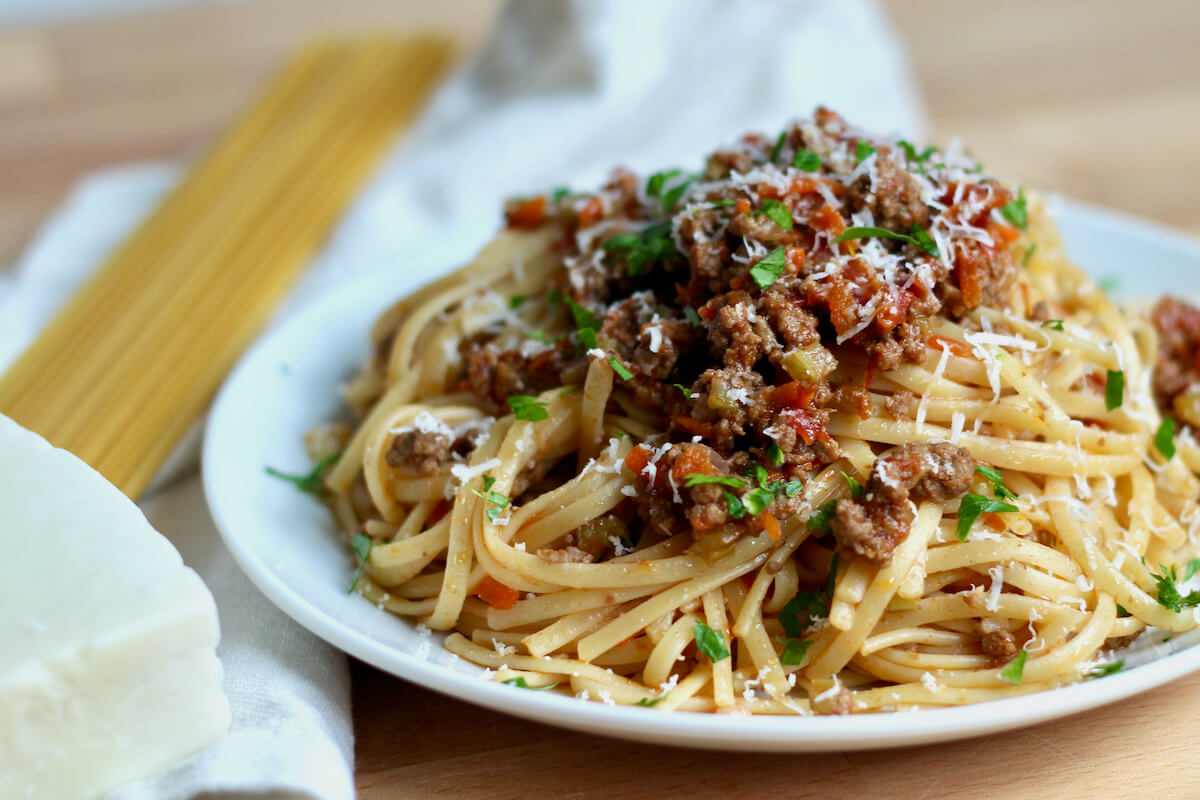
Making bolognese sauce should take all afternoon.
Simmered low and slow, the rich flavors and tender texture of beef bolognese are developed throughout the cooking process.
And while making bolognese sauce from scratch should take time, don't be intimidated. Although many of the steps are hands-on at the beginning, they are simple and straightforward. Once the sauce is simmering away, it only needs an occasional stir.
Trust me, it's worth it.
Today, I’m walking you through the entire process of making homemade bolognese sauce, including the best ingredients to use, tips that will guarantee you make it successfully the first time, and some of my favorite side dishes to serve with this authentic Italian meal.
Disclaimer: Some links throughout this post are affiliate links. As an Amazon Associate, I earn from qualifying purchases. You can learn more by visiting my Affiliate Disclosure Page.
What is Bolognese Sauce?
Bolognese sauce (pronounced bow-luh-nayz in American English) is an Italian meat-based sauce that originated near the city of Bologna, Italy.
Known in Italy as ragù alla bolognese, authentic bolognese sauce is cooked slowly and requires a series of flavor-developing steps to get just right. Traditional bolognese sauce is made using ground or finely chopped beef, fatty pork, soffritto, white wine, milk, and tomatoes.
What's the Difference Between Bolognese Sauce and Spaghetti Sauce?
Bolognese sauce is a hearty, slow-cooked, meat-based sauce with rich flavors from meat, vegetables, dairy, and wine. On the other hand, spaghetti sauce is a quicker tomato-based sauce usually made with fresh tomatoes, garlic, herbs, and sometimes meat.
Why You'll Love This Recipe
- Authentic Flavor- This linguine bolognese recipe uses many of the ingredients considered to be authentic - beef, soffritto, white wine, and milk.
- Hearty & Comforting- Tender ground beef, savory vegetables, and flavorful San Marzano tomatoes come together in this rich, slow-simmered bolognese sauce with pasta. It's the ultimate comfort food meal.
- Beginner-Friendly- Don't be intimidated by the long cook time. This simple bolognese sauce with linguine can easily be mastered by a beginner home cook - I promise!
- Perfect for Special Occasions- Whether it's for date night, Sunday dinner, or the holiday season, this homemade linguine bolognese is sure to make the day feel extra special.
- Crowd-Pleasing- A rich and hearty beef bolognese with pasta will please even the pickiest eaters at your dinner table.
Ingredient Notes
Here are some notes on the key ingredients. For the full list of ingredients, check out the recipe card below.
- Ground Beef- I find that 85-90% lean ground beef provides the best balance of flavor without creating an overly greasy sauce.
- Linguine- Linguine is thick enough to hold up to the hearty bolognese sauce. Cook the pasta to al dente according to the package instructions.
- Soffritto- A blend of onion, carrot, and celery, the soffritto provides a flavorful base for the bolognese pasta sauce.
- San Marzano Tomatoes- San Marzano tomatoes are known for their rich, sweet, and less acidic flavor.
- Milk- Simmering the ground beef in milk helps tenderize it. The milk also adds a bit of flavor and richness to the sauce.
- White Wine- Adds depth of flavor to the bolognese sauce. Use a wine you would drink such as sauvignon blanc, pinot grigio, or chardonnay.
- Butter- Unsalted butter adds a rich and creamy texture.
- Olive Oil- Opt for high-quality extra virgin olive oil for the best flavor.
- Garlic- Grated garlic blends easily into the sauce, adding an aromatic garlic flavor.
- Kosher Salt- Opt for kosher salt or sea salt that does not contain added sugar or anti-caking agents.
- Black Pepper- Use freshly ground black pepper for the best flavor.
- Nutmeg- A pinch of nutmeg adds a subtle warmth to the bolognese sauce and gives it an authentic flavor.
🌱 Sustainability Tip: Whenever possible, opt for homegrown or locally-sourced ingredients to make this bolognese sauce.
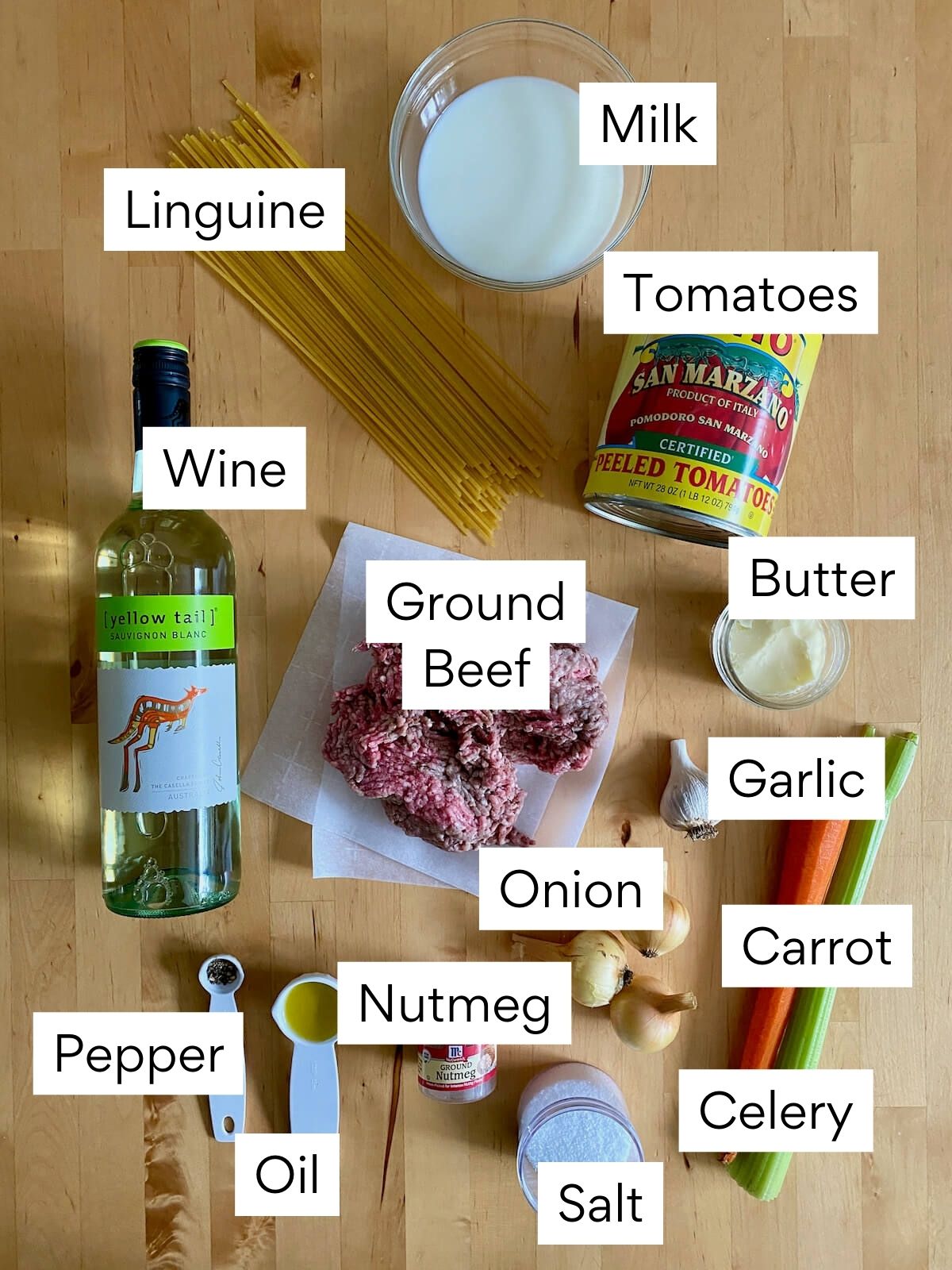
Substitutions and Variations
Here are a few ways you can try customizing this easy linguine bolognese recipe to fit your diet and taste preferences.
Substitutions
- Ground Beef- Substitute some or all of the ground beef with ground turkey, chicken, pork, sausage, tofu, chopped mushrooms, or brown lentils.
- Linguine- Any pasta shape you like can be used in place of the linguine. For a entirely scratch-made meal, make your own homemade pasta.
- Soffritto- Try replacing the onion with shallots, the carrots with red bell pepper, or the celery with fennel. Each of these substitutes will give the sauce a slightly different flavor.
- San Marzano Tomatoes- Swap San Marzano tomatoes for regular canned whole tomatoes, crushed tomatoes, or fresh tomatoes if preferred.
- Milk- Use any type of milk you prefer, including plant-based milks such as oat milk or almond milk.
- White Wine- Substitute the white wine for red wine, chicken stock, or vegetable stock.
- Butter- Replace butter with margarine, plant-based butter, or more olive oil.
- Olive Oil- Swap olive oil for any other neutral flavored oil or more butter.
- Garlic- Use ½ teaspoon of garlic powder in place of fresh garlic cloves.
- Kosher Salt- Sea salt, pink Himalayan salt, or table salt can all be used in place of kosher salt.
- Black Pepper- For a spicier sauce, use red pepper flakes in place of black pepper.
- Nutmeg- Ground mace is the best substitute for ground nutmeg.
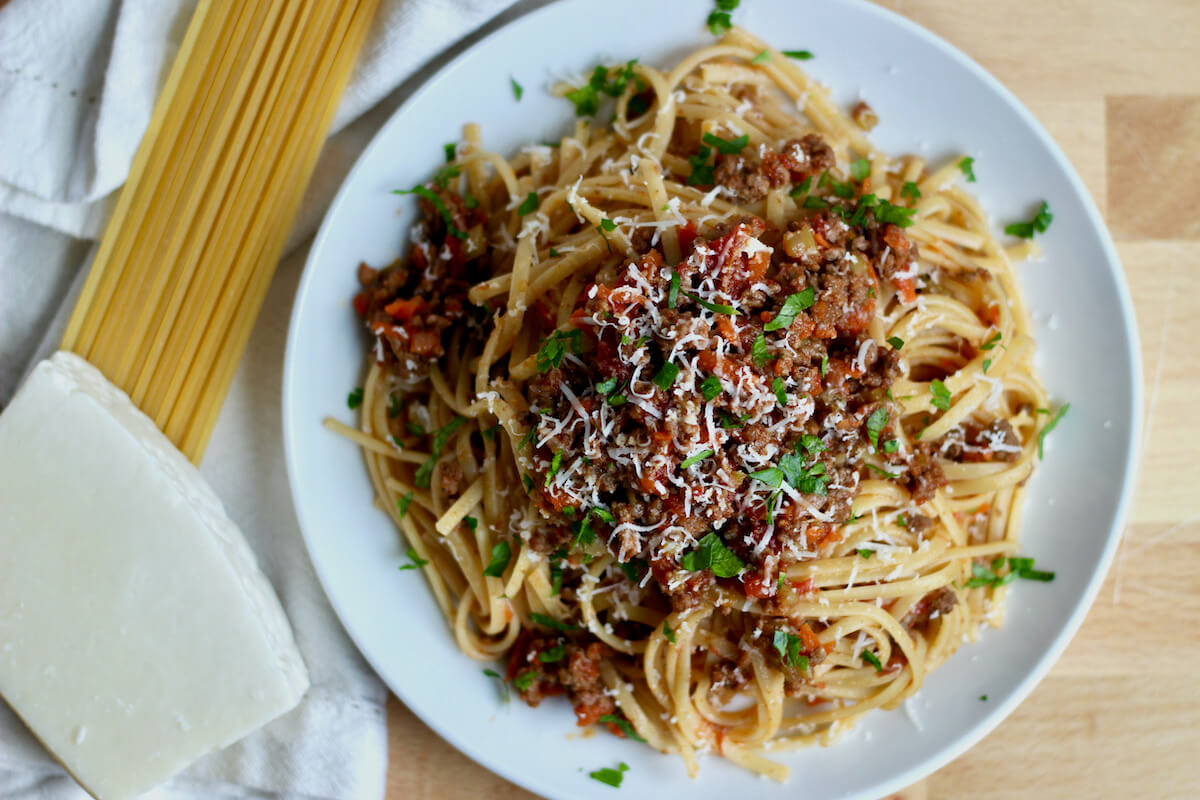
Variations
- Gluten-Free- Make gluten-free linguine bolognese by swapping regular linguine for your favorite gluten-free version.
- Dairy-Free- Substitute regular milk for dairy-free milk and the butter for additional olive oil.
- Turkey or Chicken- Swap the ground beef for ground turkey or ground chicken, if preferred, for a leaner protein option.
- Pork- Use a blend of ground beef and ground pork or ground sausage to add depth of flavor.
- Vegetarian- Replace the ground beef with brown lentils or diced mushrooms.
- Add Vegetables- Even if you're not following a vegetarian diet, adding diced mushrooms, bell peppers, zucchini, or eggplant to the sauce will provide extra flavor.
- Spicy- Add red pepper flakes to the sauce to give it a little heat.
How to Make Linguine Bolognese
Here is how to make bolognese sauce with linguine pasta.
Make the Bolognese Sauce
Step 1: Heat the cooking fats. In a large pot or Dutch oven, heat olive oil and butter over medium heat.
Step 2: Sauté the vegetables. Add the diced onion, grated carrots, diced celery, and kosher salt. Cook for 5-7 minutes until they're soft and slightly browned.
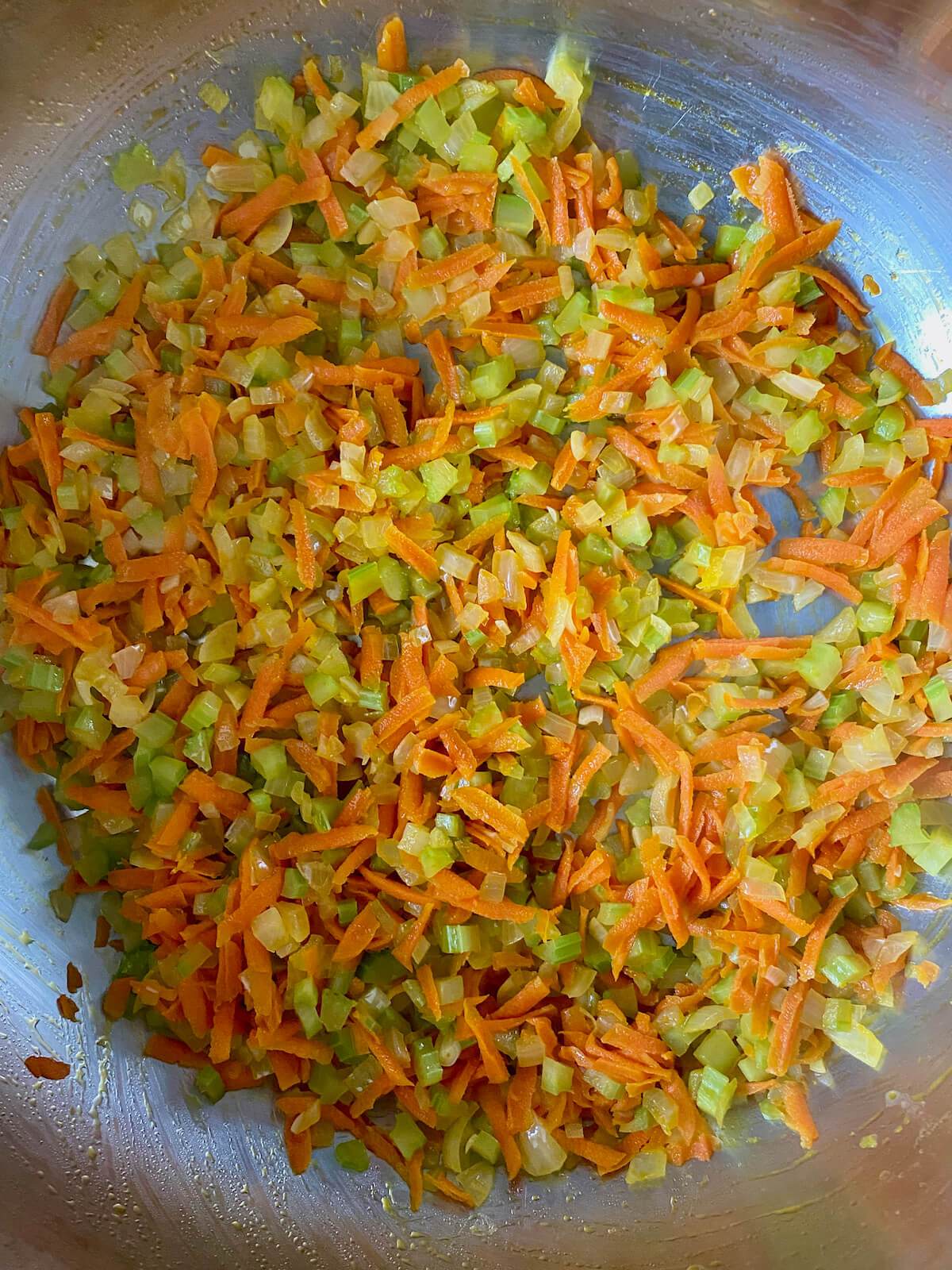
Step 3: Cook the beef. Push the vegetables to the side of the pot and add the ground beef, grated garlic, and black pepper. Break the beef up into small pieces and cook until it's no longer pink and most of the liquid has cooked off.
Step 4: Simmer the beef in milk. Reduce the heat to low and pour in the milk. Let it simmer for 10-15 minutes, stirring occasionally, until the milk has evaporated.
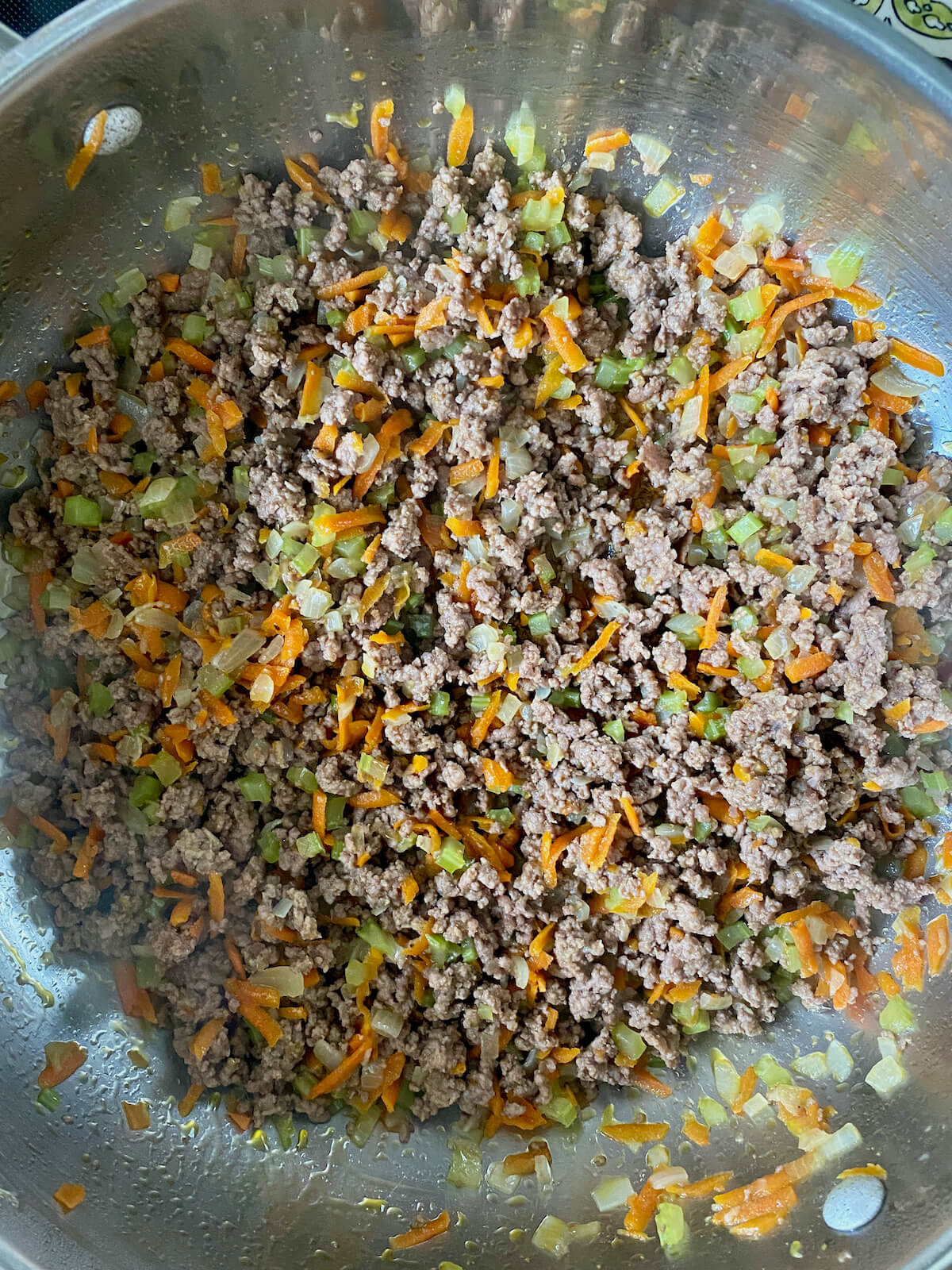
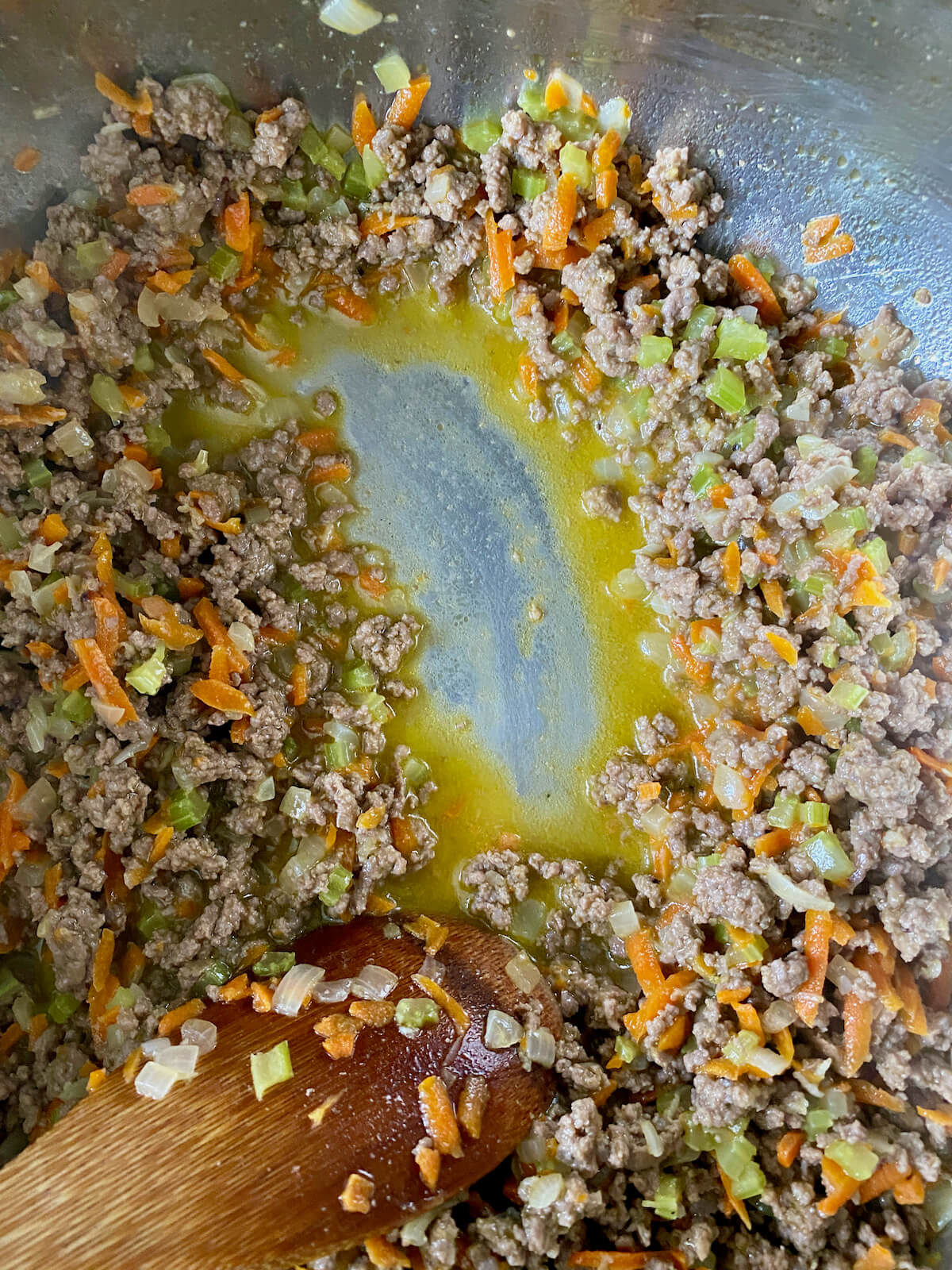
Step 5: Add the nutmeg. Sprinkle in the ground nutmeg and stir everything together.
Step 6: Simmer the beef in wine. Pour in the white wine and let it simmer for about 10 minutes, stirring occasionally.
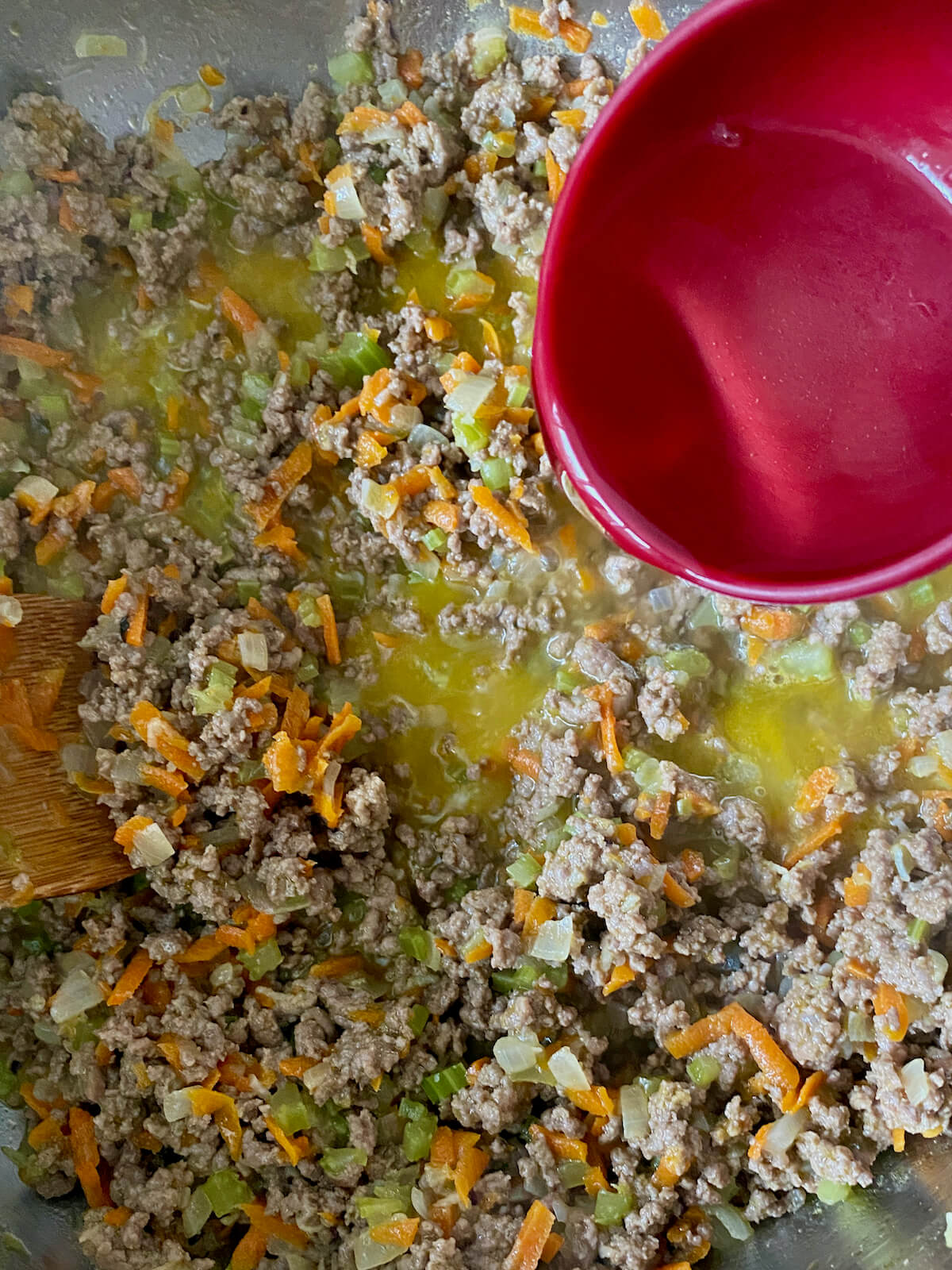
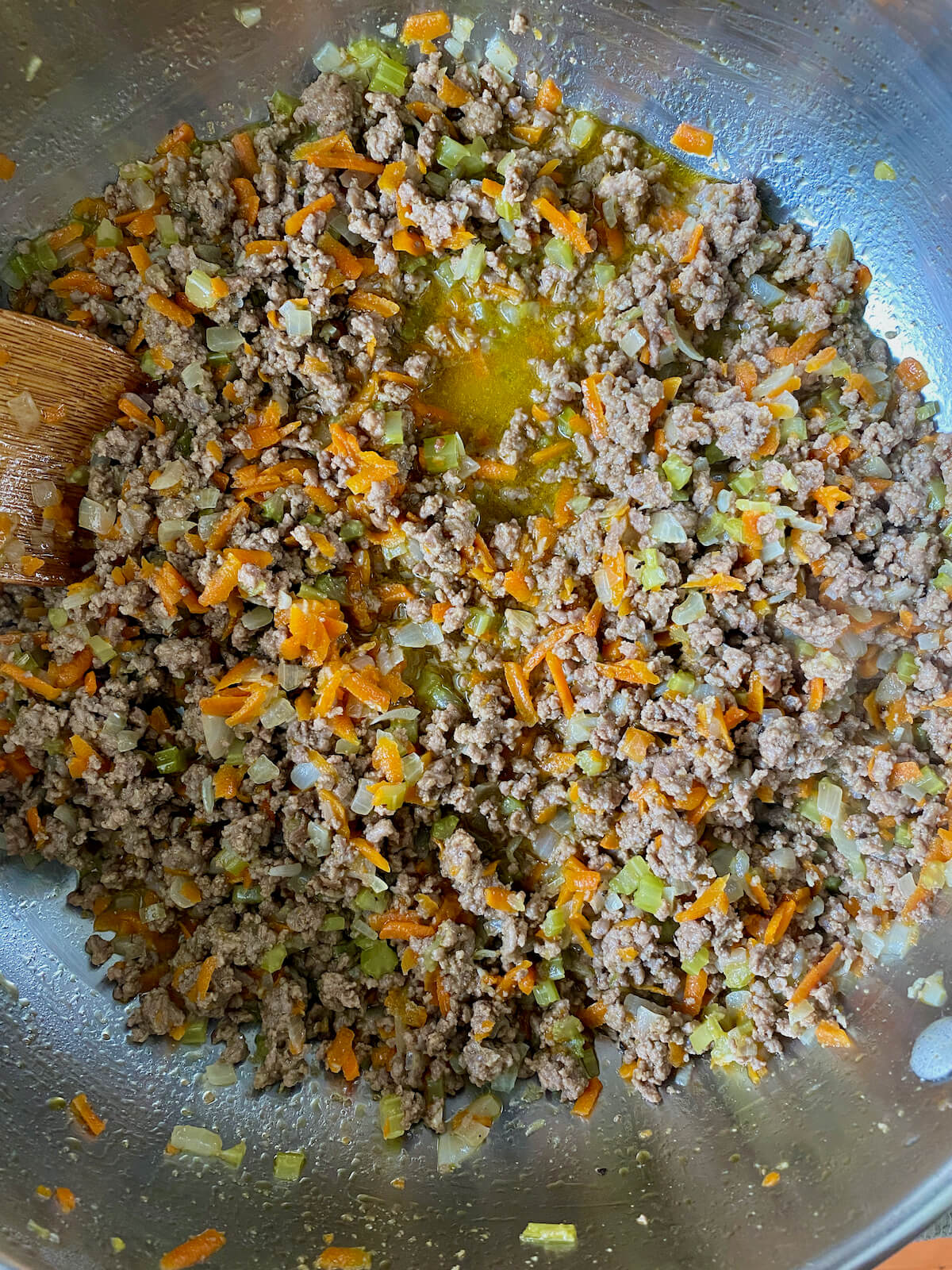
Step 7: Add the tomatoes. Add the canned tomatoes to the pot. Use your spoon to break them into smaller pieces.
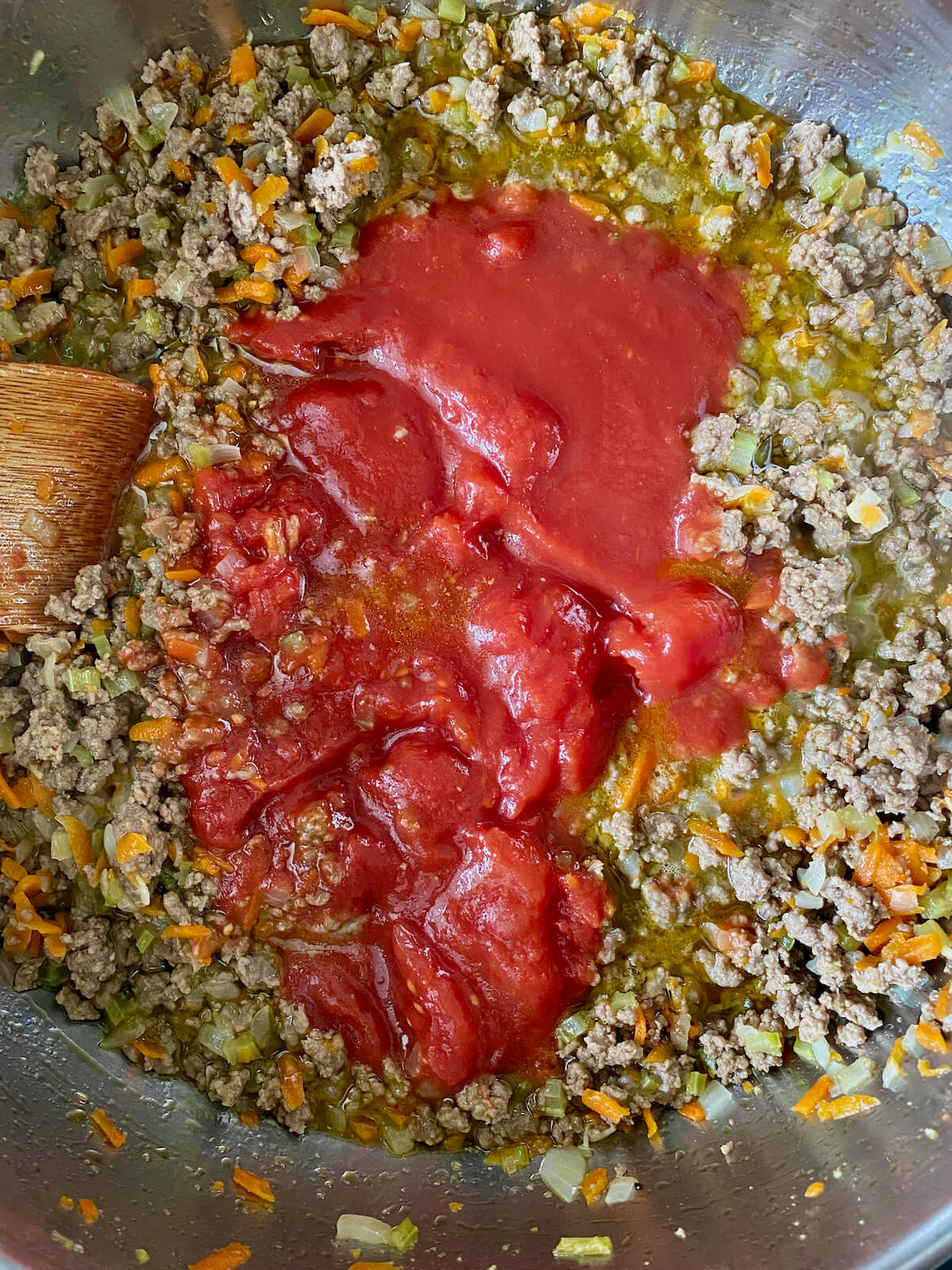
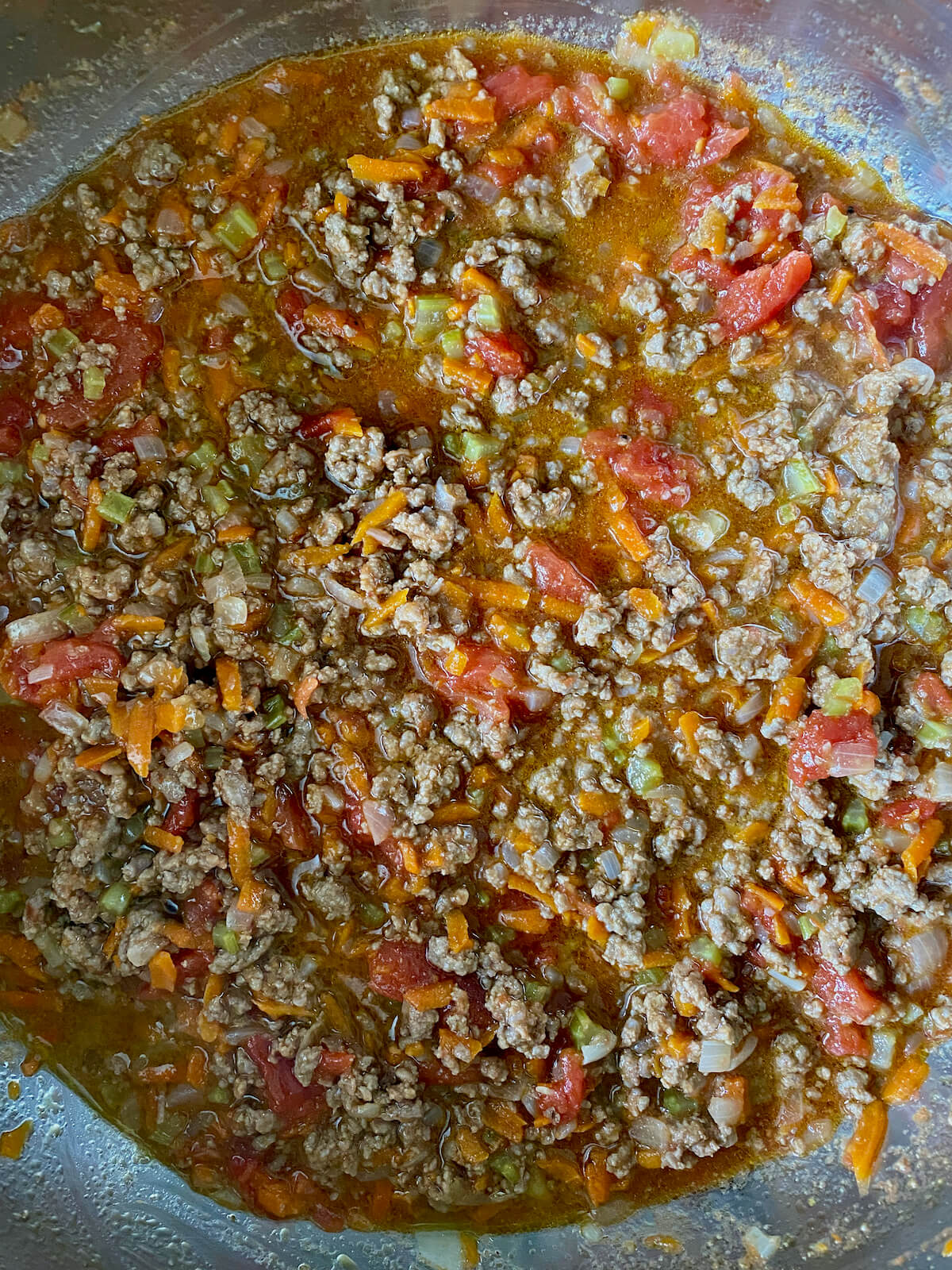
Step 8: Simmer the sauce. Let the sauce simmer uncovered on low heat for 2 hours, stirring occasionally. If it looks like it's drying out before 2 hours, add ½ cup of water. By the end, the sauce should be thick, with a bit of fat on top and very little liquid left.

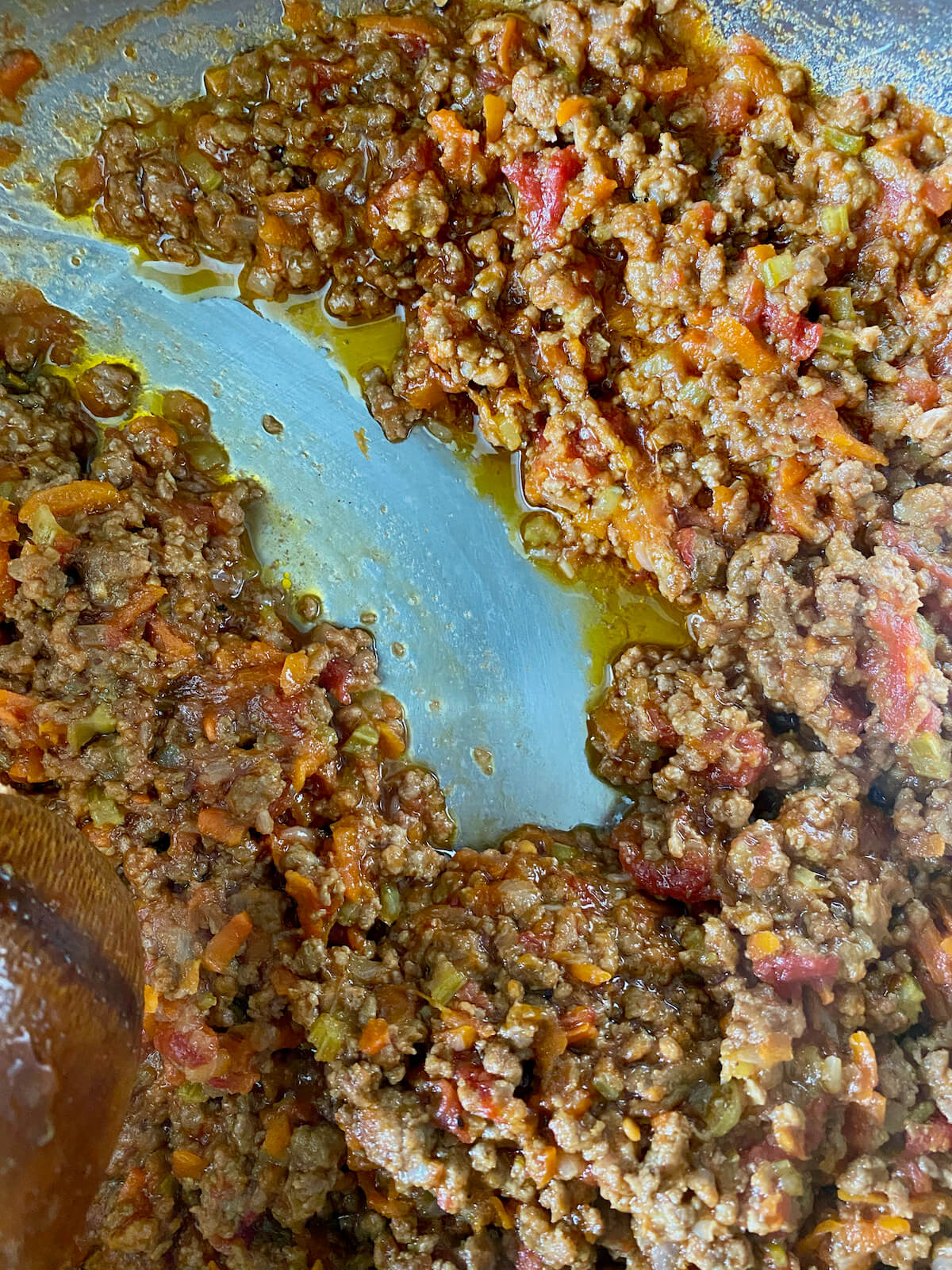
Make the Linguine
Step 9: Boil pasta water. About 30 minutes before the sauce is done, bring a large pot of salted water to a boil.
Step 10: Cook linguine. Cook the linguine to al dente according to the package instructions. Before you drain the pasta, save about ½ cup of the starchy pasta water.
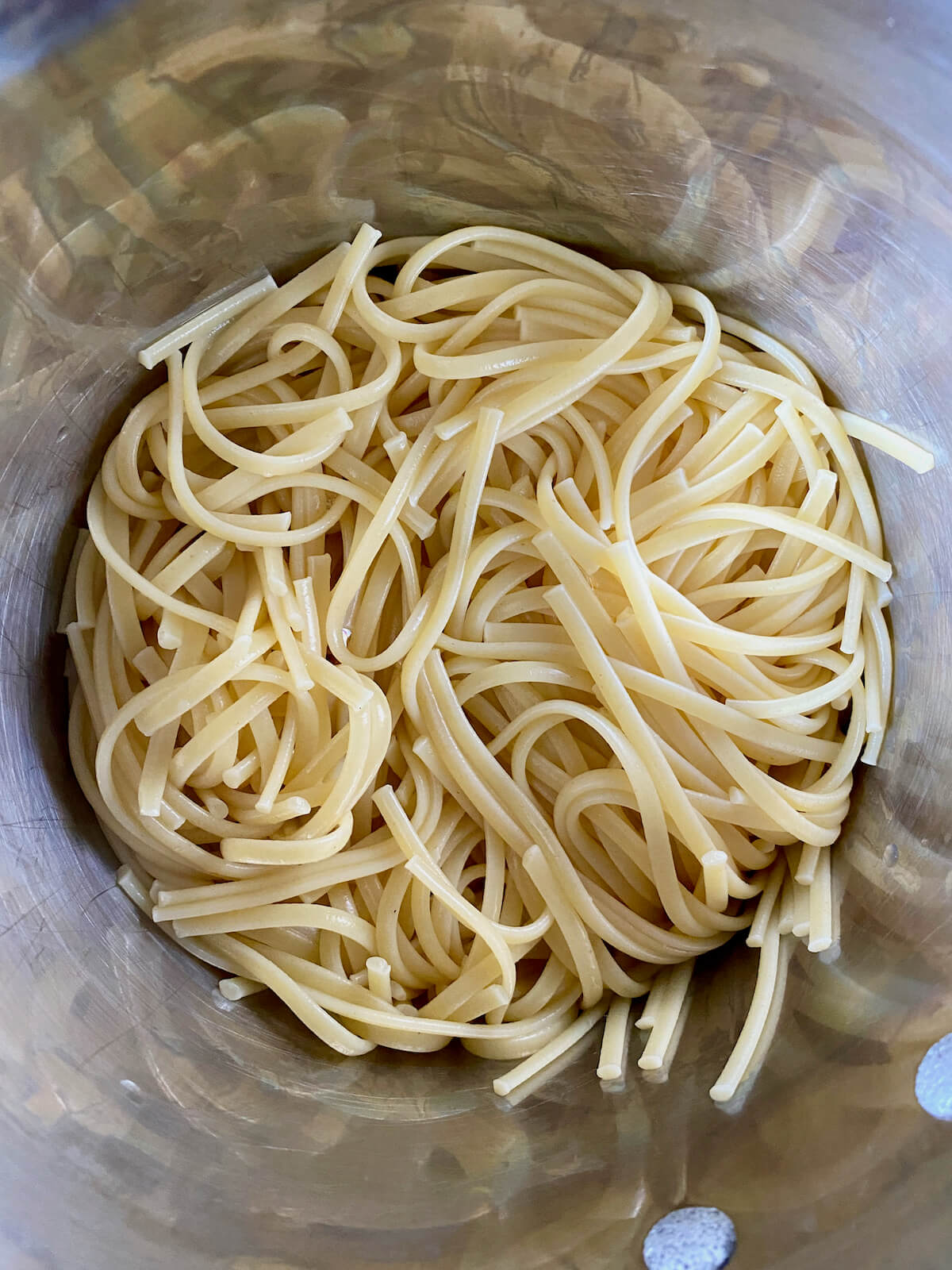
Step 11: Toss pasta with sauce. Add the drained pasta and the reserved pasta water to the pot with the bolognese sauce. Toss the pasta and sauce together until the pasta is well coated. Serve with freshly grated parmesan cheese and a sprinkle of fresh herbs if desired.
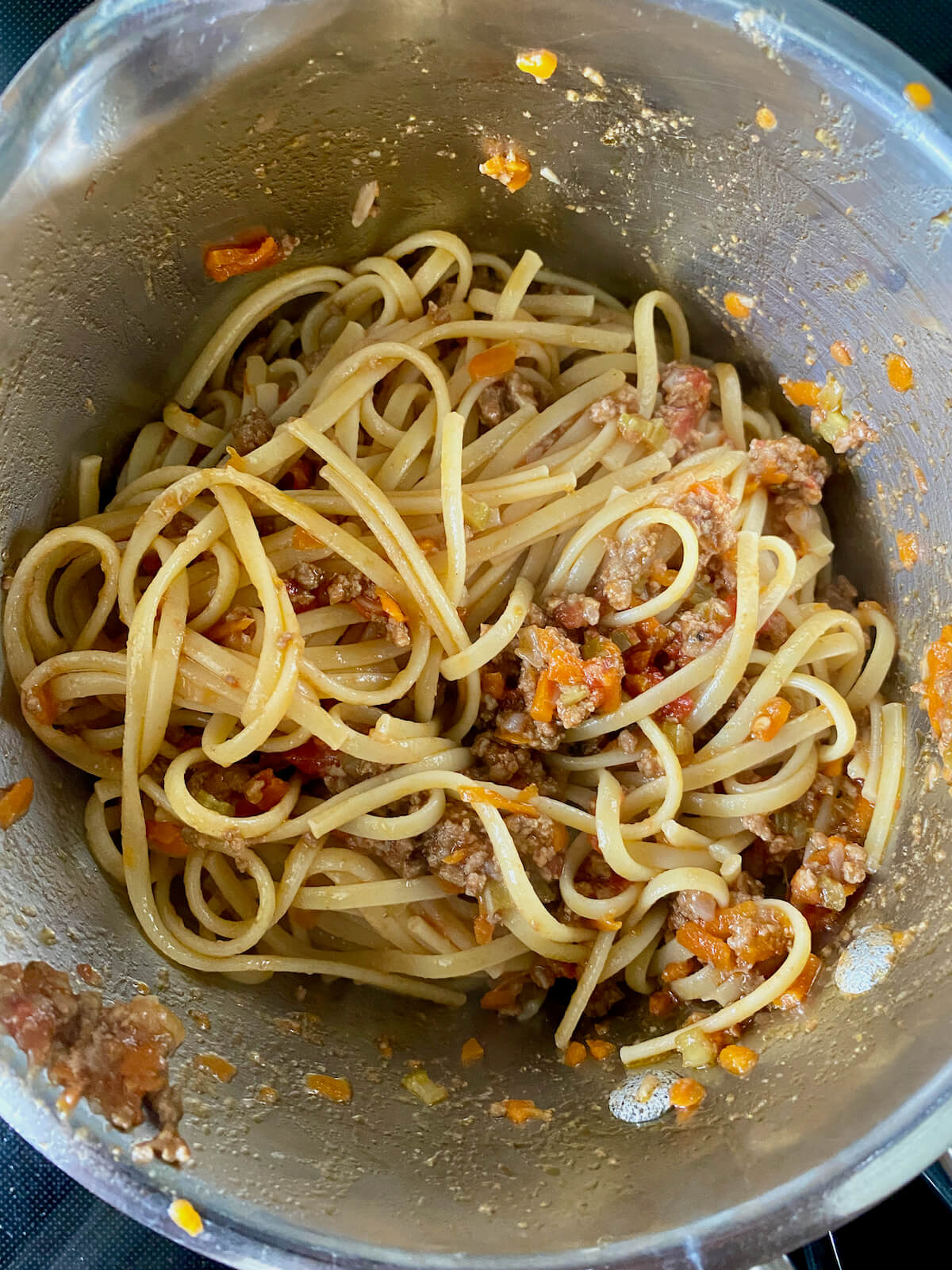
Tips for Success
Make this beef bolognese with linguine successfully the first time using these tried and true tips.
- Preparation is key. Before you start cooking, prepare all of your ingredients so you have everything ready to go. This will make the cooking process a lot smoother and more enjoyable.
- Dice the vegetables small. Dicing the onion, carrot, and celery finely ensures they cook evenly and blend well into the sauce.
- Don't rush. Bolognese sauce is meant to simmer for hours on the stovetop. Being patient with the process will help you make the best linguine bolognese.
- Cook the pasta al dente. This ensures the pasta retains its texture when combined with the sauce.
- Reserve some pasta water. Starchy pasta water will help the bolognese sauce stick to the linguine better.
What to Serve With Linguine Bolognese
Linguine alla bolognese is a hearty and satisfying dish on its own. But, it's even better when paired with tasty side dishes that compliment its flavors.
If you're really feeling the comfort food vibes, serve this homemade bolognese sauce alongside bread or breadsticks. Rustic sourdough bread, garlic bread, breadsticks, and bruschetta are all fantastic options.
Alternatively, lighten things up with a refreshing side salad. Some of my favorite salads to pair with pasta bolognese include Caprese Salad, Caesar Salad, kale salad, and arugula quinoa salad.
Finally, vegetable side dishes, such as roasted Brussels sprouts, sautéed green beans, roasted asparagus and carrots, and air fryer tomatoes, also pair will with this creamy bolognese sauce.
🍓 Planning a romantic dinner at home? Pair this meal with chocolate-covered cheesecake strawberries for a quick and easy dessert!

Storage and Reheating
How to Store
- Refrigerator- Store the leftover linguine bolognese in an airtight container in the refrigerator for 3-4 days.
- Freezer- Freeze leftover bolognese sauce separately from the pasta in a freezer-safe container for up to 3 months.
🍝 Got leftovers? Use up leftover bolognese sauce by turning it into a homemade bolognese pizza or lasagna bolognese.
How to Reheat
- Stovetop- Add leftover bolognese sauce to a saucepan and set it over low heat. If the sauce is too thick, add a splash of water to help loosen it. Heat the sauce, stirring occasionally, until steaming hot.
- Microwave- Place leftover linguine bolognese sauce in a microwave-safe bowl. Cover the bowl with a lid or damp paper towel. Heat on HIGH in 30-second intervals, stirring between each, until the pasta and sauce are hot.
- Oven- Preheat oven to 325°F. Spread bolognese sauce out in a baking dish and cover tightly with aluminum foil. Heat for 20-25 minutes or until hot, stirring halfway through.
Make Ahead
Whether you're getting ready for the holidays or just preparing for the busy week ahead, making bolognese sauce in advance can be a great way to save time and stress.
- Prepare the Vegetables- Chop the onion, carrots, and celery and store them in separate airtight containers in the refrigerator for up to 2 days.
- Cook the Pasta- Cook the pasta up to one day in advance and store it in the refrigerator until you're ready to serve. Don't forget to save some of the starchy pasta water!
- Make the Bolognese Sauce- Prepare the bolognese sauce and store it in the refrigerator for up to 3 days. Then, when ready to serve, cook the pasta and toss it with the prepared bolognese sauce.
- Freeze- Make the bolognese sauce and store it in the freezer for up to 3 months. Thaw overnight in the refrigerator before using.
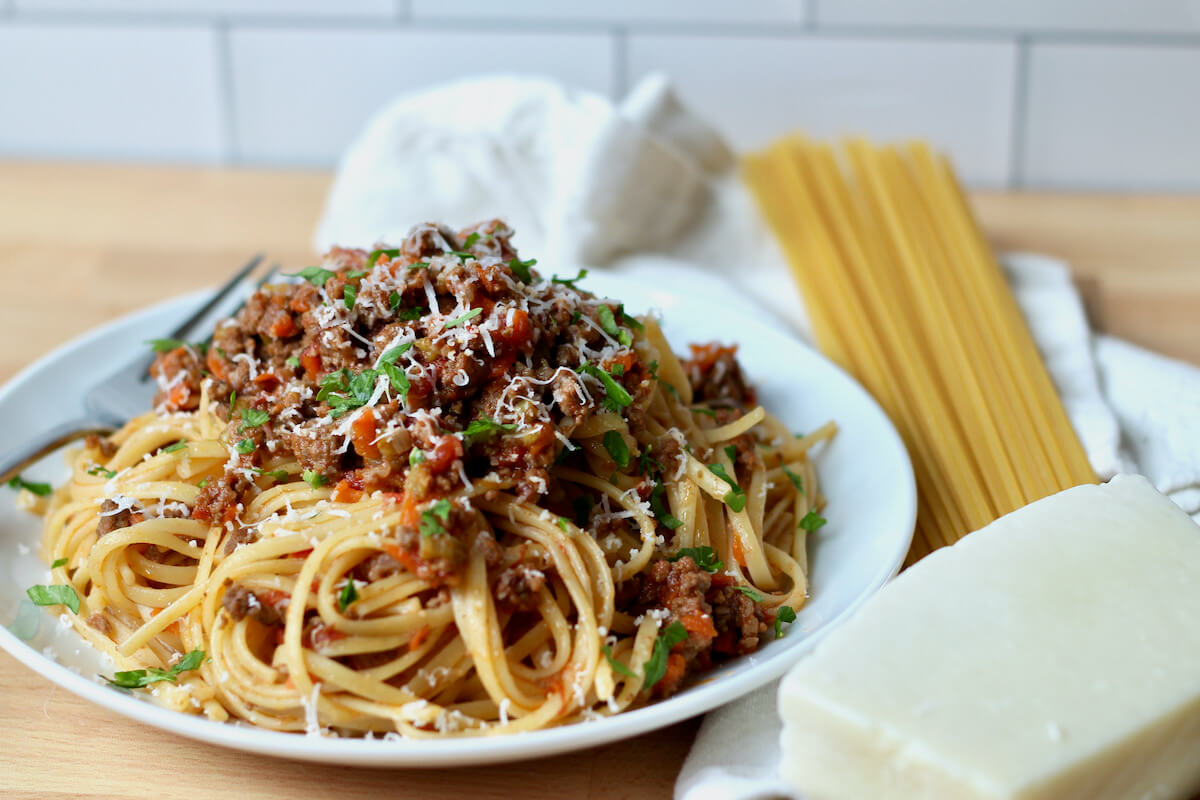
Frequently Asked Questions
The best pasta for bolognese is one that can easily hold onto the hearty meat sauce for that perfect bite. Of course, the linguine used in this recipe is a great option. Other options include tagliatelle, pappardelle, fettuccine, and rigatoni.
Yes, using whole milk will add more fat, giving the bolognese sauce a creamier texture and richer flavor.
Use a dry white wine like Chardonnay, Pinot Grigio, or Sauvignon Blanc.
Let's Connect!
Be sure to leave a comment below if you have any questions. You can also connect with me on Instagram, Facebook, Pinterest, or via email at [email protected].
📖 Recipe
Linguine Bolognese
Equipment
Ingredients
- 2 tablespoons extra virgin olive oil
- 2 tablespoons unsalted butter
- 1 large (about 2 cups) yellow onion finely diced
- 2 large (about 2 cups) carrots grated or finely diced
- 4 stalks (about 1 ½ cups) celery finely diced
- 1 tablespoon kosher salt plus more for salting pasta water
- 2 pounds ground beef 85-90% lean
- 2 cloves garlic grated or finely minced
- 1 teaspoon black pepper freshly ground
- 1 ½ cups low-fat milk
- ⅛ teaspoon ground nutmeg
- 1 cup white wine
- 1 28-ounce can San Marzano tomatoes
- 1 pound linguine dry or homemade
- Parmesan cheese or fresh herbs for serving
Instructions
- In a large pot or Dutch oven, heat olive oil and butter over medium heat.2 tablespoons extra virgin olive oil, 2 tablespoons unsalted butter
- Add the diced onion, grated carrots, diced celery, and kosher salt. Cook for 5-7 minutes until they're soft and slightly browned.1 large (about 2 cups) yellow onion, 2 large (about 2 cups) carrots, 4 stalks (about 1 ½ cups) celery, 1 tablespoon kosher salt
- Push the vegetables to the side of the pot and add the ground beef, grated garlic, and black pepper. Break the beef up into small pieces and cook until it's no longer pink and most of the liquid has cooked off.2 cloves garlic, 1 teaspoon black pepper, 2 pounds ground beef
- Reduce the heat to low and pour in the milk. Let it simmer for 10-15 minutes, stirring occasionally, until the milk has evaporated.1 ½ cups low-fat milk
- Sprinkle in the ground nutmeg and stir everything together.⅛ teaspoon ground nutmeg
- Pour in the white wine and let it simmer for about 10 minutes, stirring occasionally.1 cup white wine
- Add the canned tomatoes to the pot. Use your spoon to break them into smaller pieces.1 28-ounce can San Marzano tomatoes
- Let the sauce simmer uncovered on low heat for 2 hours, stirring occasionally. If it looks like it's drying out before 2 hours, add ½ cup of water. By the end, the sauce should be thick, with a bit of fat on top and very little liquid left.
- About 30 minutes before the sauce is done, bring a large pot of salted water to a boil.1 tablespoon kosher salt
- Cook the linguine to al dente according to the package instructions. Before you drain the pasta, save about ½ cup of the starchy pasta water.1 pound linguine
- Add the drained pasta and the reserved pasta water to the pot with the bolognese sauce.
- Toss the pasta and sauce together until the pasta is well coated. Serve with freshly grated parmesan cheese and a sprinkle of fresh herbs if desired.Parmesan cheese or fresh herbs
Notes
- Storage: Store leftovers in an airtight container in the refrigerator for up to 4 days. If freezing, consider freezing the bolognese sauce separately and making fresh linguine when ready to serve.
- Leftovers: Use leftovers to make lasagna bolognese or bolognese pizza.


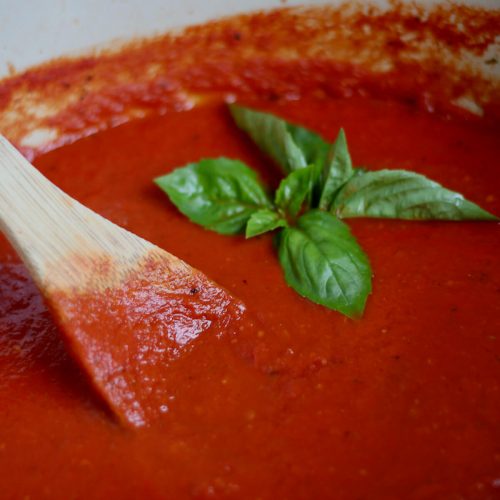
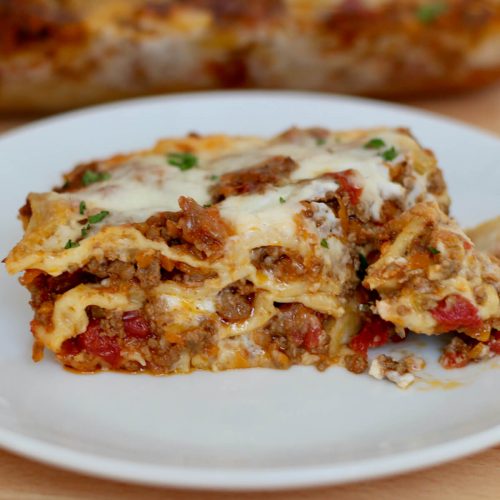
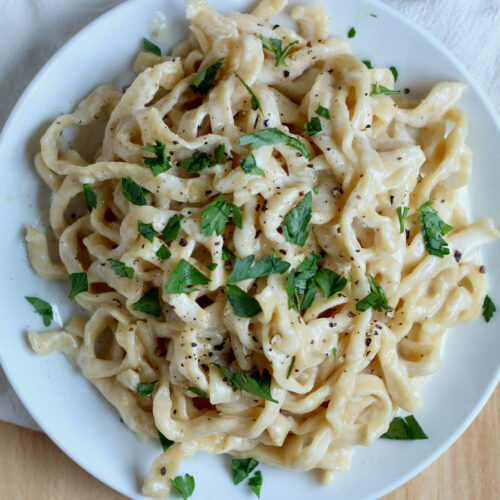



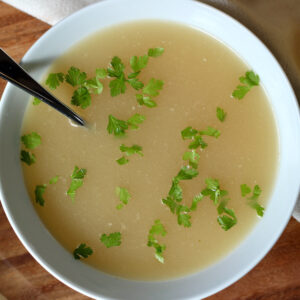

Comments
No Comments